The business news website ICv2 isn’t known for being hyperbolic. So when Milton Griepp said that this month’s comics sales had “plummeted”, everyone leaped up, screaming, knocking over chairs and spilling drinks everywhere.
Sales of comics and graphic novels through Diamond Comic Distributors dropped substantially in August with periodical comics falling 17% and graphic novels down 21%. There wasn’t a single comic title even close to the 100,000 in August.
If it weren’t for the continued strength of SCOTT PILGRIM trades, the GN drop would have been even more grisly. On the periodical side, there was no big book, but, said ICv2, certainly “the lack of one big title can’t account for everything.”
The grim details immediately set the punditocracy to arms, perhaps sniffing the hint of burning smoke in Tom Spurgeon’s Doomapocalyptigeddon which he described from his aerie high in the Misty Mountains, the same distant smell of charring paper and brimstone that we’ve been picking up for the last few weeks.
Rich Johnston was first out of the gate, bursting into the pub with a hale and hearty hallo as he called for a pint and reassured us that there was no need to get alarmed:
Of course the other explanation is much less sensationalist. Just that there were just no big ticket items in August. Figures for comics weren’t too far off from the previous month, the big difference was that the first issue or X-Men slipped from 140K to 70K for its second issue. And August didn’t see a Blackest Night hardcover, a BN: Green Lantern hardcover or a new Walking Dead book to top the charts. And reduced sales of other books, is just regular attrition that a revamped #1, a big crossover or a hor creative team will help bump at a later date. Just not in August.
So be warned of sensationalist headlines (like this one). This is not the imminent collapse of the comic shop. It’s just another one of the thousand cuts…
Given that Johnston also thinks the #1 book in August was called Blackest Knight, it wasn’t all THAT reassuring. All kidding aside, terming a 50 percent decrease a “slip” is definitely looking on the bright side.
Mike Gold at ComicMix, a student of distribution and sales if ever there was one, sat at the end of Munden’s Bar, sipping his shandy, and quickly blamed Public Enemy #1, the $3.99 price increase and The Great Comics Flood of 2010:
27 issues featuring Thor, Iron Man, and/or The Avengers. Boy, you’d think there was a Thor movie coming out that, oh I don’t know, tied in to the Iron Man movies, to be followed by the big The Avengers movie.
So, why the flood? Is Marvel worried about competition from Boom, Dynamite, and IDW? I don’t think so. They started producing material for this latest dump just about the time the Disney takeover was ratified. They are trying to impress the Mouse.
Even given similarity of sales patterns to previous dips (which we’ll get to in a minute) there is a corresponding increase in the number of titles coming out from both publishers, with a resultant dilution of talent and interest from readers.
After the loudmouth and the old-timer had had their say at the bar, the know-it-all piped up, and he brought lots of charts. Todd Allen analyzes all this and more in a piece he calls The Great August Graphic Novel Collapse which is complete with charts like the above which shows the ranking of the titles closest to 1000 units for every month for the past year. Which reveals….something. Allen concludes:
Still, August does look to have some serious shrinkage, which isn’t always the smoothest thing for budgeting a business, or for finding something to read if you wait for the trade. It has been suggested to me that retailers are increasingly inclined to re-order as they sell out, rather than buying extremely large numbers of graphic novels up front, so we could be seeing some of that here, as well. Is it a lack of new volumes in old series in August? Any way you slice it, that just was not a good month for the orders.
It does give you a little pause if you do think that a number of key series are driving the graphic novel sales. Scott Pilgrim’s had his last film-fueled hurrah and now we have to see if Bryan Lee O’Malley’s next project is embraced with the same numbers. For that matter, as successful as Walking Dead is in tpb, what would happen if Robert Kirkman was lured to Hollywood and gave up comics? That’s a lot of sales to make up if anything happened to Kirkman.
Finally, the weatherbeaten stranger in the corner threw back his hood and gave us Comichron. John Jackson Miller points out that sales right now are exactly mirroring sales from 2000, the trough of the last depression, when top sellers hovered around 100K for months, with no breakout series. Instead of unsheathing the shards of Narsil, he pulled out yet more charts and graphs.
As someone who could never understand JJM’s charts from the old Comics Retailer, this made us super queasy. However what it seems to show is that
The red line is 2010 — and we can see that comics orders have tended, for most of the last 12 years, to be right in the 5-7 million copy per month track. That continues to be the case.
While also blaming the lack of several big number books in August, Miller goes on to make a very detailed comparison of 2010 and 2000 including similar factors — a hit movie, a price increase:
There are differences with 2000, too, of course, making the unit sales comparison problematic. 2000 was near the bottom of a long industry recession; 2009-2010 are years coming off a period of relative growth, and there aren’t the kind of structural problems driving down sales that we contended with in the late 1990s. Marvel had many fewer comics coming out each month in 2000. Downloads for comics, authorized and otherwise, were far less readily available. And as noted before, month-to-month comparisons across time have other problems in comics.
But all that said, we do still have about the same number of comic books being pulled from UPS boxes and placed on shelves each month as we saw back then. Now, as I’ve mentioned before, these identical numbers for the comics unit sales category are not a sign of market stagnation overall, because since 2000, the industry has enjoyed hundreds of millions of dollars worth of sales of trade paperbacks that didn’t exist back then. The market has grown in dollars and units — it’s just those units are trade paperbacks, where 2010 is concerned. And periodicals rebounded nicely in the 2000s, with energy behind projects like Civil War and a stronger general economy. So the narrative is not that sales haven’t increased since 2000; rather, we are not keeping pace with the best years of our run.
He concludes that we are just one hit away from everything rebounding, yet another positive spin on what seems to be an eroding base.
OVERALL DIAMOND SALES (including all comics, trades, and magazines)
August 2010: approximately $32 million ($35.5 million including UK)
Versus 1 year ago this month: -11%
Versus 5 years ago this month: -2%
YEAR TO DATE: $270.66 million, -5% vs. 2009, +18% vs. 2005
And The Beat. What do we think about this, sipping a glass of Malbec at a booth? We’d like to direct you to yesterday’s column by Rich Johnson, the most succinct write-up we’ve yet seen of the changes at Marvel and DC in the year since both underwent drastic management/ownership changes.
Marvel and DC are still the industry leaders, at least as far as the comics media and loudest fandom is concerned, and whither they goest, we goest. And the truth is, both have been in transitional periods this year.
Marvel has been pumping out a lot of material, some of it excellent, some of it not. But there is no question that the mini events haven’t taken hold as in the days of Civil War and the Death of Cap. This could be general event burnout or …maybe people really do like big events. The DiDio Doctrine states that big mammoth tie-ins that make every book in the line successful are the only way to keep today’s distracted consumers focused on your line…he’s yet to be proven wrong.
As The Beat’s Rich Johnson pointed out, despite all the upheaval, there has actually been little change in management at both companies. Marvel is still run by the same canny brain trust that got them to the point of Disney thinking the company was worth $4 billion. Marvel has also been successful at bringing along new writers — but the truth is a Bendis or Johns only comes along once every few years. There isn’t anything that has the “MUST BUY THIS IS IT” feeling of some past projects.
Over at DC the situation is dicier. After dithering for four months over who to hire to replace Paul Levitz, they left mostly the same folks in charge that were already running things, but didn’t replace some of the lower levels left vacant by promotions. The doubts over the impending move, a hiring freeze, and so on, have left DC’s main business in a holding pattern. Given all the distractions, its little wonder DC has lagged in establishing any new businesses to replace the ones they’ve shut down.
Our email has been full of people suggesting that 2010 is just one big transitional year. Given the wider uncertainty over the economy, people have a lot on their minds, and comics aren’t doing that much to distract us from our problems, esp. given the price tag of periodical comics.
Which isn’t to say that the next big thing isn’t right around the corner. It seems pretty clear, even from Miller’s level-headed analysis, that we are nearing the end of a cycle of some sort. At $4 for a story you can read in 5 minutes, we’ve reached the tail end of the Satisfying Chunk™ formula. The manga collapse hasn’t helped, and the end of the bookstore market as we knew it has been a big setback — if book sales were THE growth segment of the Aughts, it’s a segment that isn’t growing any more. We have to find new ways to find an audience. Period.
Of course, comics aren’t going to go away or end or turn into video games. Having just returned from SPX where great comics and great cartoonists were multiplying like bunny rabbits, it’s hard to take the August numbers as anything but the logical softening of a certain market. Other markets will spring up. It’s just who will create them and profit from them that everyone must figure out.
So by the time everyone had their say, it was last call and everyone gathered their charts and headed for a warm bed. Munden locked the door behind them. A chilly, rainswept wind sprang up, and it smelled like change.


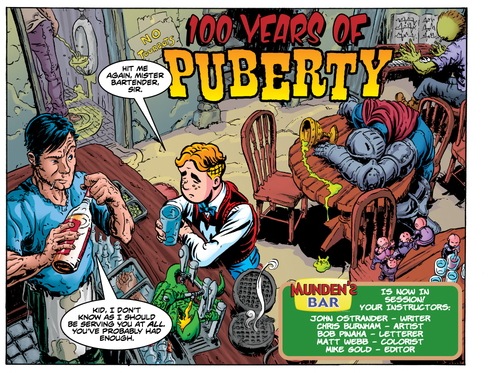

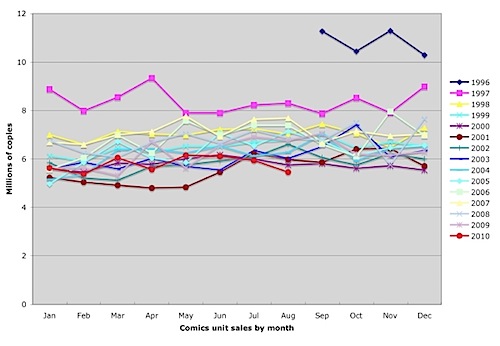

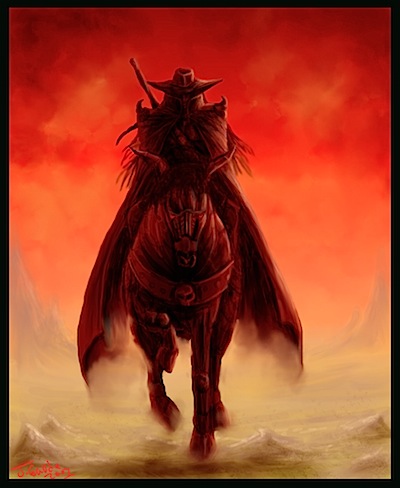
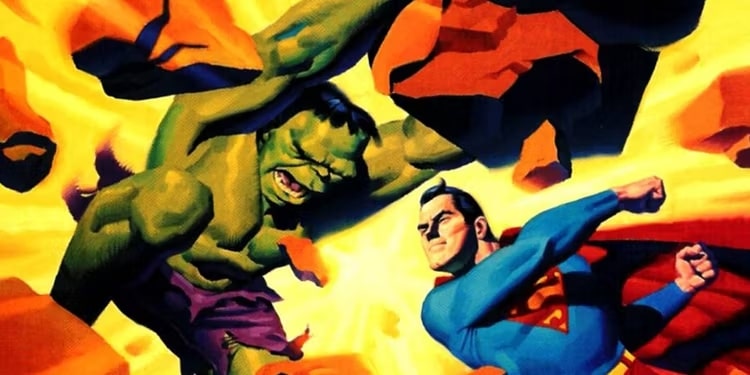

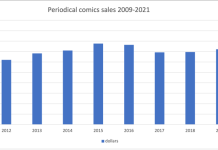



I want to ask a question that I believe I know the amsswer to – so here’s the question. The charts that ICv2 uses are sales into comic shops from Diamond – correct?
When someone verifies that I am not insane I will follow up with a comment.
1) Regular publishers of graphic novels hold their good stuff for the Fall and Holiday season. Comics publishers do the same, and anything else which might be a best seller is released in July, to coincide with San Diego. However, 2010’s August would be similar to 2009’s August.
2) How does the first nine months of 2010 compare to the same nine months from 2009?
3) The bigger picture: the Top 300 charts are also an indicator on how well Diamond is doing as a business. Unlike the quarterly reports a publicly traded business issues, we get monthly reports.
4) In the bookstore business, the chains are shifting emphasis to stuff which can’t be downloaded, such as toys and gifts. Are comics shops shifting their product mix to t-shirts, toys, and games?
5) Mr. Miller, if you intend to compare sales over a multiple of years, may I suggest you use a vertical bar graph, where each month is grouped together? This way, a month’s sales can be compared from year to year, and by following the color from month to month, trends can easily be discerned. That plate of spaghetti featured above is almost impossible to decode. If that’s not possible, then please stretch the y-axis scale. Or better yet, flip the axes, using the x-axis for the dollar figures.
6) Has anyone produced one long historical graph? Can the graph be run through a stock-market analyzer to predict trends and the general profitability?
CRAP! Got hit by the email bug!
The above post is by me, not Marc Deering.
I caught the mistake two seconds after I hit “submit”. My apologies to Mr. Deering.
Yes, Rich.
-B
It certainly seems to be the time for all things “Thor” now in the lead up to the 2011 movie. The proliferation of comics, games, figurines and various other artefacts.
I can recall a time not so long ago when it was the opposite. Michael Oeming had finished his magnificent “Rune Thor” comic book series and there was a long hiatus before JMS took over for a while as comic book writer for Thor.
During that “hiatus” about the only thing being written on Marvel Thor were my various fan fiction stories. You can still enjoy them. Just scroll down below my author profile and you will see over 40 fan fiction stories here:
http://www.fanfiction.net/u/1276881/David_Scholes
Cheers
Brian – thanks for clarifying. These are orders in people! Not an indication of how books are selling at comic shops. We seem to have an unusual penchant for analyzing everything about this medium. I can’t think of another part of publishing that gets dissected like comics and graphic novels. I love numbers – but I think this sends people into a unwarranted tizzy.
Marc, it’s INTENDED to be a plate of spaghetti. The individual years there aren’t intended to be pieced through — rather, the idea is that we see that the red line is, generally, within the bounds of the pack. If you visit the link to my site, you’ll see charts with the key years pieced out.
I have long historical graphs here: http://www.comichron.com/vitalstatistics/alltime.html
And in answer to another of your questions, the first eight months of 2010 compare thusly to 2009:
Comics periodical units, down 6%;
Comics periodical dollars, down 3%;
Top-selling TPBs, down 9%%;
Combined Top 300 comics & trades, down 4%;
OVERALL (including all Diamond comics, trades, and magazines), down 5%
And, Rich, the charts you see at ICV2 and my site are based on the raw tables that Diamond releases, and which appear on its website; we use known comics sales to figure out what their index number is, and thus zero in on the estimates we provide.
Marc=Torsten. I stand corrected!
Yeah, I’d actually considered making all the non-2010 years the same color, since the point of this particular graphic was not specific comparisons, but just to superimpose all the monthly tracks and show that most of them existed in a narrow range. But I was pretty sure there would be a “what year is THAT?” question on some of the outlying years.
Anyway, if you’d like to compare individual months from year to year, I do that on every individual monthly page on my site — 1-year, 5-year, and, where available, 10-year tracks going back to the 1990s. Just go to http://www.comichron.com/monthlycomicssales.html.
The thing is, Rich (or should I say, “Gigi”?) that the odds are terrific that actual sell through is significantly lower. Speaking very very generally retailer orders lag behind the actual real-world demand by at least a month on the chart.
In other words, on an August chart, you’re actually seeing the reflection of what retailers thought the customers would buy based on sales in July, or, in some/many cases, June or even May.
-B
Thanks! Those charts are helpful.
Torsten asked a question about previous Augusts for the tpbs over at http://www.indignantonline.com/2010/09/14/the-great-august-graphic-novel-collapse/
and when I pulled the August numbers back to 2003 (when you only saw the top 50 tps)… you certainly could interpret the sales level dropping back to something similar to ’03, depending on where you extrapolate the 1000-copy level falling.
Coming out of a boom cycle does look like a reasonable theory. We’ll see what next month’s charts look like. You’d think it would take a little longer for any trickle-down from people giving up on the monthlies to people giving up on the trades.
My feeling has been all along that if any portion of the direct market was going to be more sensitive to the general economy, it was going be trades and particularly hardcovers, which tie up relatively more retailer dollars per SKU than comics. A relatively modest trimming of inventory levels in stores in the “long tail” is usually enough to shake up the whole chart. An interesting measure would be what the turn-rates are right now for key trades in stores; that would tell us a lot, if it could be tracked nationwide.
1) I think things will either get better or they will get worse.
2) The “satisfying chunk” is still out there, still being offered by a number of people, it just doesn’t always feature Marvel or DC superheroes. It’s not dead by any means. It’s just not popular with creators or editorial, because the satisfying chunk isn’t easy to put together anymore without Stan Lee captions, and no one wants to tell their two-issue arc in two issues anymore when they can make six issues worth of paychecks and then get a thicker, more expensive book collection out and perhaps royalties as the cherry on top. And, this method of plotting/writing also allows folks to write more books per month, nosing arcs along with fewer panels, more spreads, less actual writing. Unless they’re dialogue fetishists, and just type whatever the editor allows.
3) That crazy color chart looks more like Galactus’ Best Friends Bracelets collection than a plate of spaghetti. To me, at least.
4) This is fun! Anybody can do this! Blah blah blah, my opinions have merit because I put them on the internet. I’m a comic industry pundit! Wheeee!
5) BTW, the sky is falling.
6) Please forget anything I’ve said, because no one will bring it up later, anyway, when they’re discussing more charts and trends and doing comparisons and hitting the mark of things about as often as a carny fortune teller.
7) Atlas/Seaboard’s back, we’re saved! Satisfying chunks are Comin’ At Ya, in 3-D!
8) I understand completely if few people get that last reference, because I am sad.
9) I need some better hobbies.
10) The first rule of Fight Club is, Fight Club really wasn’t very good.
How the hell did a smiley face appear instead of the #8? I’ve never put an emoticon out in the world in my life.
I feel sick…
It’s payback…I deserve it, I guess…
The first rule of Fight Club is, you do not talk badly about Fight Club.
You made that up! You did!
The huge second-issue drop for X-MEN isn’t particularly surprising. All books have a big second-issue drop; heavily hyped books especially so; and when the first issue has a horde of variant covers, the effect is magnified still further. It’s really too early to draw any conclusions about where the book will wind up.
Heidi, I’ve dropped you an email, you seem to have some sort of weird spam problem in your RSS feed.
I’m not the writer of the 6th comment. That “Gigi” is a fake.
What a smart and intelligent joke…
Brian
I undrstand that retailers order to what they thibk their customers will buy – so this may be due more to the horrific economny and maybe, just maybe it was a month where the releases weren’t that strong. What id it compare to with last year’s releases. I very well know that sometimes you have weak months in the publishing schedule. Hell, sometimes you have a weak year.
Oh, amd I am Gigi – but only on the weekends. Rich
@Evan: “It’s just not popular with creators or editorial, because the satisfying chunk isn’t easy to put together anymore without Stan Lee captions, and no one wants to tell their two-issue arc in two issues anymore when they can make six issues worth of paychecks and then get a thicker, more expensive book collection out and perhaps royalties as the cherry on top. And, this method of plotting/writing also allows folks to write more books per month, nosing arcs along with fewer panels, more spreads, less actual writing. Unless they’re dialogue fetishists, and just type whatever the editor allows.”
Amen to that! I agree 100% with your assessment of the pathetic “decompressed” storytelling style that’s taken over the Big Two. Combine that 5-minute reading experience with a $4 price point, and for me it’s certainly a reason to avoid more titles than I’d otherwise be inclined to check out.
In my own writing, I try hard to make my individual issues of the “satisfying chunk” variety. But then again, I’m not writing for Marvel or DC.
A 50% drop from issue 1 of X-Men to issue 2 is hardly worth a major panic.
Bet the drop was worse last time…
BATMAN AND ROBIN, RETURN OF BRUCE WAYNE, GREEN LANTERN, FLASH and several other books missed their August shipping dates. Counting those four alone, that’s about 300K in unit sales and a million in dollar sales.
And if you look what’s actually on the chart, a lot of recent launches are doing surprisingly well — as well as new launches haven’t done in a couple of years, in fact.
How the hell did a smiley face appear instead of the #8?
WordPress feature. It takes the 8 followed by the close parenthesis and assumes that you mean for it to be a smiley.
Heidi, that was a REALLY well-researched piece, and to be honest with you, my sales for this past August were WORSE than any month I have had in nearly a 5 year span. I actually had to go out of pocket to pick my new product up in the whole month, and for the first week of September. September sales are up, but not yet worth calling home to Mom about as of yet. I am filling out the November order form tonight while watching Vampire Diaries with the Wife, and will be doing a LOT of cutting (think Freddy Kruger style cutting). The $3.99 and up price point is just a crippler, and with Diamond’s discount structure not being what it used to, you really can’t discount off cover price if you care to make any money. I did find the Milton Griepp and Mike Gold appearances in the piece to be enjoyable nostalgia from the good ol’ days…
Since those numbers are Diamond based, I’m kinda curious what the actual drop off is. I’m ordering the vast majority of my graphic novels through Baker & Taylor instead of Diamond because:
1) I get nearly the same discount (sometimes better).
2) Shipping is much cheaper.
3) I can return unsold stuff.
4) They’ve always sent me the items they bill me for.
5) In the few years I’ve been doing business with them, I’ve only had a handful of damages (for which replacements were shipped at no cost to me).
I’ve been dealing with Diamond at my current store for nearly eight years, and those last two points are something that happens about 80% of the time.
Which is a long way of wondering if there’s been a substantial shift in where direct market stores are getting their graphical novels. Anyone?
Juat as a vague add-on to what Brian and Rich have been talking about, I’m also seeing a lot of underordering by retailers on certain books. True Blood & Morning Glory have been hugely under-ordered judging by the amount of reprints, just as Shadowland and many of the Curse of the Mutants tie-ins have. Hell, even the first 4 issues of Young Allies have been a total sell-out. While people are buying less comics in some cases, retailers are being a little more cautious than they maybe need to be.
Of course that’s probably linked to the amount of books that Marvel and DC are putting out at the moment, only so many dollars to go around…
“Oh, amd I am Gigi – but only on the weekends. Rich”
I’ll have to chose another secret identity for the weekends! :-)
I think that the blog had a little bug. Sorry!
Am I the only one who thinks that it’s both sad and pathetic that the only way for the Big 2 can raise sales on their comics these days is to use short term gimmicks like variant covers,crossovers,and “controversial” and/or shocking mainstream news media grabbing stories (like the death of Captain America and lesbian Bat Woman)?
In addition to the gimmicks, the only other over used ideas that the Big 2 can think of to boost there sales (or keep their sales from falling even further) is to over expose (or make clones of) the same 12 characters,ratchet up the “adult” content, and having the same 4 or 5 “top/hot/popular/critical acclaimed” creators work on their top comics and guide their respective universes.
Marc-Oliver Frisch makes an excellent point. At least on the monthly comic side of the equation, I can’t see any individual titles where there were any abnormal declines. A lot of strong sellers simply were not shipped in August.
Thanks for the cold comfort, Heidi.
Now if my Diamond checks would just materialize, I’d be happier.
Dave
One thing to keep an eye on that I haven’t heard many people discussing…indy books. Recently several smaller companies upped the retailer cost, so that $4 book now costs 5-10% more per issue for the retailer, necessitating a 60% sell through to break even. I wonder how much of an effect that’ll have on orders, and whether or not it’ll necessitate a $4.50-5.00 price point for smaller press single issues, and more importantly, if the industry will support it.
As is, I could imagine retailers cutting orders on back catalog stuff because buying another $4 Lantern book will be more likely to sell AND make them more money.
In any event, the bottom half of the chart will be an interesting watch.
Another indicator might be the number of books for the 300th best seller. That would indicate that if there are no “must haves” or event books, or no number 1’s, then comic buyers are shifting their dollars to other books.
I have taken the $4 price point and left. I am no longer sampling the books, choosing to wait for reviews of the entire series before committing to purchasing anything. By then the collected edition has been solicited and looks more attractive than 5 to 6 individual issues with ads. Then instead of 20% discount at my LCS, I can get close to 40% at Amazon. This is the fall of the direct market.
There was once a time I would come home every Wednesday with a bag full of books. Today my pull-list consists of a single comic (that needs to be “special ordered”… that book is Erik Larsen’s SAVAGE DRAGON).
The majority of mainstream comic books I find on the shelf these days just don’t captivate me (like they started to do again back in 2001-2006). I’d even go as far as to say that the direct market has become a stagnant pond. If it weren’t for those few comic book shops that go above-and-beyond the call of duty to bring in great alternative and independent books, and if it weren’t for online sellers giving me massive selection, and if it weren’t for all the conventions I’ve been attending to promot my OWN comic, I’d literally have nothing on my read pile. Except my special ordered Savage Dragon.
So I can’t say this sales plummet surprises me in the least.
Micah, the 300th place titles and their volumes across time are here:
http://www.comichron.com/vitalstatistics/300thplace.html
It’s not on there yet, but the figure this month was 2,646 copies. The figure is much higher than it was a decade ago, when the major publishers were offering fewer titles.
Someone asked what the drop-off was on X-Men #2 the last time around, in 1991. It was MUCH higher — 82%, dropping from the all-time industry record of 8.19 million copies for #1 to 1.47 million copies for #2.
If the dollars being spent on comics were consistent (or chalked up to standard attrition), then there wouldn’t be a dramatic decrease in overall spending. Comic buyers would just shift their dollars to something else. In the case of August this would mean that BECAUSE there wasn’t a mainstream event book (or books) then people held on to their dollars instead of trying other books out. Again, the $4 price point would prevent me from considering that book. I would consider a $4 book with a specific creative team that I like, but an unproven or unknown team working on a peripheral superhero book for $4? There is no way I’m going to try it out. I will wait for the reviews and then maybe get the collected TPB.
Set your own life more simple get the personal loans and all you need.
Comments are closed.